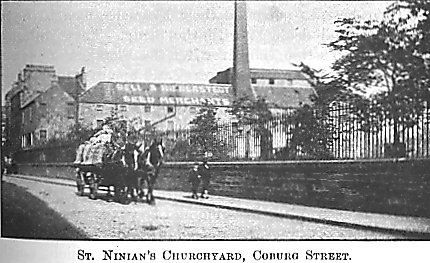When viewed from the south
side of the river, from the neighbourhood of the Shore or the Coalhill,
the most outstanding feature of North Leith, in spite of the many tall
lands that have grown up around it, is still, as in olden days, the
steeple of this older parish church, which looks extraordinarily
picturesque with its windows of latticed wood, its old clock face, its
quaint decoration, and its metal-covered roof, surmounted by an
old-fashioned weather-cock. This old weather-cock, whose more ancient
predecessor is yet to the fore, still proudly shows where sits the wind;
but the clock, by which the North Leithers in days of old used regularly
to set their own, has long ceased to mark the passing hours, while the
church-going bell which used to ring the curfew every night at ten oíclock
no longer swings in the quaint old steeple, but has found a safe
resting-place in another part
of the parish. For this building, once sacred to Godís worship, has for
nearly one hundred years been degraded into a warehouse for storing goods.
Yet we would rather have the old church reduced to these base uses than
see its picturesque old steeple removed altogether from the skyline of
North Leith. But of this there is no fear so long as the various flats
into which the building has been divided continue to remain as they are
constructed at present, for within the ancient steeple is the only stair
by which they are reached.
We owe the record of our
early history to the Church, but the Church was not simply a recorder of
history. It was in many instances the chief maker of it. And this
weather-worn church, round which the older North Leith seems to cling,
suggests to us that in tracing its history we shall be led to the very
beginnings of North Leith; and so we are, for the church, like the town,
owes its origin to the Abbey of Holyrood. Davidís great charter to this
much-favoured Abbey in 1143, confirming it in its many possessions, gives
us our earliest peep at North Leith as the home of a few fisherfolk, serfs
of the Church of St. Cuthbert. Along with that ancient foundation it
became a possession of the canons of Holyrood, to whom the Church of St.
Cuthbert, with all its pertinents, was gifted by the "sore
saint."
Isolated as they were from
the greater worlds of South Leith and Edinburgh by the Water of Leith, the
inhabitants of the little hamlet in those distant days do not seem to have
allowed this obstacle to hinder their attendance at the Abbey Church, then
the parish church for the Canongate and North Leith. We have an
interesting and even touching picture of this congregation at worship, and
of the kindly relations existing between its members and their good
friends the canons, in an old charter now a possession of the Edinburgh
University Library.
In this charter we have the
sacristan and other leading canons of the monastery coming before the
parish altar on the morning of April 2, 1486, and there, in time of high
mass, the parishioners being congregated in magna óthat
is, in great numbersóexplaining how Brother Lathrisk, their parish
clerk, who for so many long years had gone out and in among them, because
of his age and feebleness had resigned his office into the hands of their
venerable father in God, Robert Ballantyne, the abbot; and how the lord
abbot had, with the consent of the convent, nominated Patrick Ballantyne
to succeed him in his charge, if it was the wish of the parishioners that
he should do so. Then, at the request of the parishioners, their old
parish clerk was called, who asked them to receive his successor, as he
himself, because of his age and infirmity, could no longer fulfil his
duties. Then all the parishioners, with unanimous consent, approved of
what the lord abbot had done.
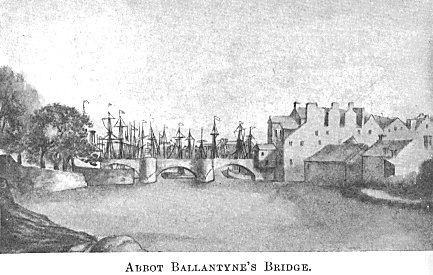 That
venerable father in God, the Lord Abbot Ballantyne, into whose hand old
Brother Lathrisk resigned his office of parish clerk, was a great
benefactor to North Leith, which then, and for many generations after, was
often spoken of as the Rudeside, after the Abbey to which it belonged.
Their good abbot, in order to give more ready and convenient access to his
little township of the Rudeside, in 1486 replaced the inconvenient ferry
and the oft-times dangerous ford by means of a bridge "of three
stonern arches," for churchmen were the bridge builders in
pre-Reformation days. In those times, when travelling was beset with so
many difficulties and dangers, bridge building and road making were looked
on as pious and meritorious works before God, like visiting the sick and
caring for the poor.
That
venerable father in God, the Lord Abbot Ballantyne, into whose hand old
Brother Lathrisk resigned his office of parish clerk, was a great
benefactor to North Leith, which then, and for many generations after, was
often spoken of as the Rudeside, after the Abbey to which it belonged.
Their good abbot, in order to give more ready and convenient access to his
little township of the Rudeside, in 1486 replaced the inconvenient ferry
and the oft-times dangerous ford by means of a bridge "of three
stonern arches," for churchmen were the bridge builders in
pre-Reformation days. In those times, when travelling was beset with so
many difficulties and dangers, bridge building and road making were looked
on as pious and meritorious works before God, like visiting the sick and
caring for the poor.
This bridge crossed the
river at the Old Bridgend, now gone like many another old landmark, and
the roadway that led from it, the Old Church Street of to-day, formed the
main street of the little town until 1788, when the drawbridge at the
Tolbooth Wynd was formed, and gave it a new main thoroughfare in Bridge
Street. The good Abbot Ballantyneís bridge was then removed, as it
interfered with the shipbuilding. Its site was, however, commemorated down
to the close of the Great War by the group of houses so long known as the
Old Bridgend, behind which, always closed by a rough iron grating, was a
narrow passage leading down to the water. This was part of the ancient way
that led to the abbotís ferry superseded by the bridge "of three
stonern arches" in the fifteenth century.
A few years later, in 1493,
Abbot Ballantyne gave further proof of his solicitude for the welfare of
his vassals on both sides of the river in Leith. Just as Brother Lathrisk,
their old parish clerk, had found the long way to St. Leonardís and the
Rudeside beyond his aged strength, so there must have been feeble and
delicate folk among the abbotís vassals there for whom service at the
Abbey Church meant a long and weary journey. Abbot Ballantyne, therefore,
erected at the north end of the bridge the Church of St. Ninian, in later
days the parish church of North Leith, and endowed it with the rents of
the tenements which afterwards came to be known as the Old Bridgend, and
with the tolls of wayfarers crossing the bridge. Here down to the
Reformation two priests continued to minister faithfully to the religious
needs of the Abbeyís vassals in Leith, and every morning at six oíclock,
in accordance with the good abbotís injunctions, St. Ninianís bell was
to ring out, calling the inhabitants to early Mass, which the two priests
were to celebrate in turn on alternate weeks.
It has always been thought
that Abbot Ballantyne founded the Chapel of St. Ninian in North Leith
because its inhabitants had no other place of worship, but this does not
seem to have been the case, for just at this period there comes into
notice for the first time another chapel in North Leith of whose history
practically nothing is known beyond the fact that, like St. Anthonyís in
the Kirkgate, it seems to have been the chapel of a hospital. This chapel
and hospital, to which a burial ground was attached, stood at the junction
of the Citadel and Johnston Streets. They were very appropriately placed
under the invocation of St. Nicholas, for
"St. Nicolas keepes the
Mariners from danger and disease
That beaten are with boystrous waves and test in dredful seas,"
and North Leith has always
been noted for mariners.
And just as St. Anthonyís
Hospital was founded before St. Maryís Kirk in South Leith, so that of
St. Nicholas would seem to have been erected long before St. Ninianís,
to which Abbot Ballantyne gave no churchyard, an omission that is
unaccountable save on the supposition that North Leith already possessed
one at the Chapel of St. Nicholas. And in the churchyard of St. Nicholas
the good folk of North Leith continued to bury their dead until 1656, when
chapel and churchyard were displaced by Cromwellís citadel.
James: IV., who was ever a faithful son of
the Church, sometimes worshipped at this chapel. His accounts show these
two among several similar entries :ó
"Offerit in St.
Nycholase Chapel, in Leith beyond the brig, vii s."
"To twa puir laddies beside Sanct Nicholas Chapell of Leith, xid."
As St. Nicholas was the
patron saint of seamen, this hospital, like that of the old Trinity
Hospital in the Kirkgate, may have been, in the first place, for aged and
decayed mariners. It must have been a prominent object to those
approaching Leith from the sea, and mariners, returning from a long and
prosperous voyage, would not forget the good St. Nicholas who had safely
brought them where they longed to be. Neither St. Ninianís nor St.
Nicholasís would escape injury during Hertfordís devastating
invasions, and at the Reformation the Chapel of St. Nicholas was allowed
to fall into ruin, and all records connected with it were lost.
Among the last authentic
notices of St. Nicholasís Chapel is one in connection with the death of
Mr. Muirhead, the first minister of North Leith after the Reformation, who
in 1612, we are told, died in his upper chamber of the old manse of St.
Ninian, which still stands beside the church, "and was buried in St.
Nicholasís Chapel on Friday thairafter at the west gavel." But
workmen in digging trenches for drains and other works in and about the
foot of Dock Street, a thoroughfare that has displaced the ancient St.
Nicholasís Wynd, often uncover the bones of those who found their last
resting-place in the old churchyard of St. Nicholas so many centuries ago,
and wonder how they came to be there.
At the Reformation the
possessions of the canons of Holyrood in Leith were bestowed by James VI.
on John Bothwell, who stood high in royal favour, and his indulgent master
at the same time created him Lord Holyroodhouse. The Chapels of St. Ninian
and St. Nicholas then fell into decay. Some time later the Chapel of St.
Ninian, along with the chaplainís house, the tithes of Hillhousefield
and of fish brought into Leith and Newhaven, were sold to the inhabitants
of North Leith, which included St. Leonardís, the abbotís lands
between the Bridgend and the "Blak Volts" of the Logans of
Coatfield. The church and chaplainís house having become ruinous, were,
in 1595, either repaired or rebuilt, for it is recorded "thair has
been ane kirk re-edified on the north side of the brig of Leith."
This re-edified kirk and chaplainís house became in 1606 the parish
church and manse of North Leith, Pilrig, Bonnington, Newhaven, and
Warriston ("the bonnie Warriston" of the old tragic ballad).
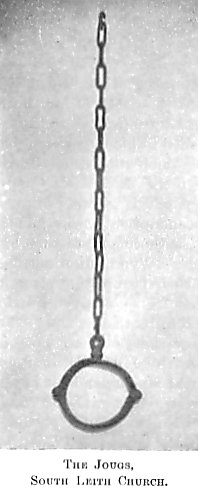 The
earliest date to be found on the present one-time parish church of North
Leith is the year 1600 on a great inscribed lintel that stood over the
main entrance to the church. The manse was afterwards extended across the
front of the church, and access given to the doorway by a pend beneath the
addition to the manse. Above this pend was placed the lintel of the now
hidden doorway, and manse, pend, lintel, and church may all be seen to-day
by peeping within the gate of the oil and paint stores of which they now
form part. The walls of this older church are easily distinguished by
their greater thickness from those of later additions and alterations.
The
earliest date to be found on the present one-time parish church of North
Leith is the year 1600 on a great inscribed lintel that stood over the
main entrance to the church. The manse was afterwards extended across the
front of the church, and access given to the doorway by a pend beneath the
addition to the manse. Above this pend was placed the lintel of the now
hidden doorway, and manse, pend, lintel, and church may all be seen to-day
by peeping within the gate of the oil and paint stores of which they now
form part. The walls of this older church are easily distinguished by
their greater thickness from those of later additions and alterations.
Like the churches of South Leith, Restalrig, and
Duddingston, that of St. Ninian had attached to some part of its fabric
the jougs in which offenders against the law, both of church and town, had
to undergo punishment. Thus on June 1605 one Peter Waugh, who had caused
much trouble to the authorities, was on his next offence to stand in the
jougs "frae morne to even."
In Chapter XI., dealing
with the trade guilds of Leith, which included in their membership most of
the townsfolk in mediaeval times, and which played at least as great a
part in promoting religious services as in developing trade and industry
in the town, we found that the guilds of North Leith joined those of the
Canongate in the support and upkeep of the guild altar and chapel in the
Abbey Church rather than uphold altars for themselves in their own Church
of St. Ninian. They began this when Holyrood was the only place of worship
for the abbotís vassals, and had continued it as their own members were
few and their funds small. After the Reformation, however, when altars and
chantries had all been swept away, the trade incorporations, as we must
now call them, benorth the brig, like those on the south side of the
water, had as large a share in the work of the church as in the days
preceding the Reformation. This is sufficiently indicated in the fact that
the cornmunion cups still used in the present parish church of St. Ninian
in Madeira Street were gifted to its ancient Predecessor by the
"Masters and Maireners," the ship-builders and carpenters of
North Leith in 1673, while the baptismal font was presented by the trades
of North Leith at the same date.
The Ship Carpentersí
Incorporation held an important place among the trade guilds of North
Leith, which has always been the shipbuilding quarter of the town. Before
the days of steamships the carpentersí yards, as the shipyards were then
called, lay along the north bank of the river and were reached by narrow
winding closes which ran down to the waterside from Old Church Street and
Sandport Street. One of these carpentersí yards of bygone days, so long
known as Innesís, is seen in the picture of Old North Leith at the
beginning of this chapter.
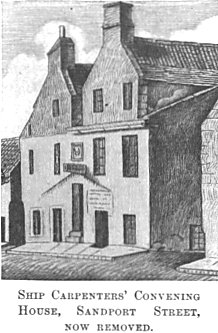 How
Edinburgh became possessed of North Leith we have already seen, and how
the chapel and burial ground of St. Nicholas were removed by General Monk
in 1656, to make way for Cromwellís citadel, we shall hear in due
sequence. By Monkís act of vandalism the North Leithers were left
without a place of burial for eight years. During that period they were
beholden to their good neighbours of South Leith for leave to bury in
their churchyard. As it had been by Edinburghís aid that the Citadel was
erected at all, it was to the provost and magistrates of the city that the
North Leithers turned for a new place of burial, and after repeated
importuning they were given, in what is now Coburg Street, "a garden
extending to the river bank," which remained the only place of burial
of the little town until the opening of Warriston and Rosebank Cemeteries
in 1843 and 1846 respectively. Unfortunately the church records of North
Leith for these very years are wanting, if they ever were written, for
during some of those years the North Leithers, like their neighbours in
the larger world of South Leith, having strong hankerings after "the
king over the water," were denied the use of their church for fear of
their minister taking the opportunity to foster and encourage their
royalist tendencies from the pulpit. The church meanwhile was used as a
storehouse for munitions of war.
How
Edinburgh became possessed of North Leith we have already seen, and how
the chapel and burial ground of St. Nicholas were removed by General Monk
in 1656, to make way for Cromwellís citadel, we shall hear in due
sequence. By Monkís act of vandalism the North Leithers were left
without a place of burial for eight years. During that period they were
beholden to their good neighbours of South Leith for leave to bury in
their churchyard. As it had been by Edinburghís aid that the Citadel was
erected at all, it was to the provost and magistrates of the city that the
North Leithers turned for a new place of burial, and after repeated
importuning they were given, in what is now Coburg Street, "a garden
extending to the river bank," which remained the only place of burial
of the little town until the opening of Warriston and Rosebank Cemeteries
in 1843 and 1846 respectively. Unfortunately the church records of North
Leith for these very years are wanting, if they ever were written, for
during some of those years the North Leithers, like their neighbours in
the larger world of South Leith, having strong hankerings after "the
king over the water," were denied the use of their church for fear of
their minister taking the opportunity to foster and encourage their
royalist tendencies from the pulpit. The church meanwhile was used as a
storehouse for munitions of war.
Monk is said to have
allowed the good folk of North Leith to remove their tombstones and even
their dead from the churchyard of St. Nicholas to the new burying ground
by the river bank. When we remember that eight years were to elapse
between the loss of the old and the grant of the new cemetery, we see at
once that this story is mere legend, with no basis of fact beneath it, and
certainly there are no tombstones from the older churchyard of St.
Nicholas in the burial ground in Coburg Street to-day.
Many generations of North Leithers
"Who have worked their
work, now reap
The unfathomable sleep "
of the dead within the old
burial ground, as it has now long since become. Beyond that little can be
said of those who lie there, for of few of them is there now any memory
even in Leith itself, and yet some, judging by the coats-of-arms on their
tombs, had been people of note in the social world of their own time.
Perhaps the one best known to general fame is Robert Nicoll, the
"Keats" of Scottish poets, whose high poetic promise was cut
short by untimely death when he was scarce out of his teens.
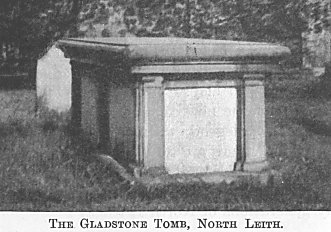 Just
forenent the gate of the churchyard is the great altar-like tomb of Thomas
Gladstone, the grandfather of the famous statesman. Perhaps it was
constructed in this fashion as a protection against the "body
snatching" of the Resurrectionists, for down to the first quarter of
the nineteenth century this old graveyard was a lonesome spot, and on dark
nights these foul robbers would steal up the harbour, fasten their boat to
a branch of one of the overhanging trees of the burial ground seen in the
picture of the old bridge, and then go about their ghoulish work.
Just
forenent the gate of the churchyard is the great altar-like tomb of Thomas
Gladstone, the grandfather of the famous statesman. Perhaps it was
constructed in this fashion as a protection against the "body
snatching" of the Resurrectionists, for down to the first quarter of
the nineteenth century this old graveyard was a lonesome spot, and on dark
nights these foul robbers would steal up the harbour, fasten their boat to
a branch of one of the overhanging trees of the burial ground seen in the
picture of the old bridge, and then go about their ghoulish work.
Thomas Gladstone was a corn
merchant on the Coalhill, but his house was at the head of King Street,
where the site is indicated to-day by an inscribed tablet. The Coalhill,
then one of the chief business streets of the town, formed part of the
"Hill" district, as the abbotís lands of St. Leonardís were
now called, and a portion of the parish of North Leith, although on the
south side of the water. The Coalhill was so named in the eighteenth
century because it was here that vessels bringing coals for public sale
were berthed. They were charged no shore dues, and all other vessels had
to give place to them.
The Gladstones
"sat" in North Leith Church for over forty years, where old
Thomas Gladstone was elder for the "Hill" district. This would
almost seem to indicate that the family had resided here before they
became established in the King Street house, and, if so, then Sir John,
the father of the famous prime minister, would be born in the Coalhill,
and not in King Street. The Gladstone mansion in King Street was burned
down just over twenty-five years ago. James Gledstane, as they then spelt
their name, the brother of Thomas, was parish schoolmaster of North Leith
from 1769 to 1799. The old schoolhouse may yet be seen within a pend in
Bridge Street. It is now a painterís store.
The minister of St. Ninianís
in old Thomas Gladstoneís day was Dr. Johnston, who was always lovingly
and familiarly spoken of, especially by the fisherfolk of Newhaven, then
among his parishioners, as the "bonnie Dr. Johnston," from his
handsome appearance and refined and courteous manner. He was minister of
North Leith for the long period of fifty-nine years, from 1765 until 1824.
Between the Gladstone and Johnston families there was a lifelong
friendship, and the famous statesman used to tell how as a little boy he
met Dr. Johnston in Glasgow. The good doctor, then eighty-two years of
age, had walked all the way from Leith, and intended walking all the way
back again.
That same year he preached
his last sermon in old St. Ninianís to a crowded congregation. The old
church had become too small for them, and being crowded to the roof with
gallery upon gallery was stuffy and unhealthy from want of proper
ventilation. The congregation were about to move to a new church (the
present building in Madeira Street), which, like St. Anthonyís, had been
built in the fields beyond the town, and like it, too, was ere long to
find itself in the heart, instead of the outskirts, of the town.
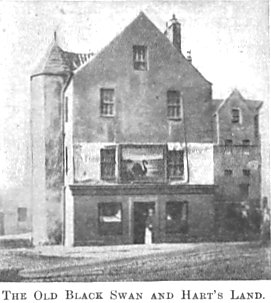 For
eight years Dr. Johnston was to continue their pastor in the new building,
and then, in 1824, at the age of ninety-two, he passed to his rest, and
was laid among his own people in the old burial
ground of St. Ninianís, where a plain recumbent slab marks his grave;
and in the same year the old church, which had become the nursery of two
other congregations ó Coburg Street and Junction Road United Free
Churches ó passed from sacred to secular uses. Two old buildings stood
for long years beneath the shadow of St. Ninianís Churchóthe old Black
Swan, the village inn, and Hartís Land, a weatherworn tenement with a
dovecot gable. Hartís Land has in recent years lost much of its
quaintness, and all trace of the old
Black Swan has now disappeared, for it was rebuilt in 1892.
For
eight years Dr. Johnston was to continue their pastor in the new building,
and then, in 1824, at the age of ninety-two, he passed to his rest, and
was laid among his own people in the old burial
ground of St. Ninianís, where a plain recumbent slab marks his grave;
and in the same year the old church, which had become the nursery of two
other congregations ó Coburg Street and Junction Road United Free
Churches ó passed from sacred to secular uses. Two old buildings stood
for long years beneath the shadow of St. Ninianís Churchóthe old Black
Swan, the village inn, and Hartís Land, a weatherworn tenement with a
dovecot gable. Hartís Land has in recent years lost much of its
quaintness, and all trace of the old
Black Swan has now disappeared, for it was rebuilt in 1892.
The Black Swan of our day is merely
an up-to-date public-house. It lacks all the quaint picturesqueness of its
ancient predecessor that used to speak to us so eloquently of its
old-world past. The Black Swan of days of yore was the great
trysting-place of North Leith. Close by stood the village well where
gossiping dames and pretty serving-maids would forgather to fill the
household stoups, and exchange pleasantries with the jolly sailor lad who
came with water-barrel for the supply that was to serve the shipís crew
on the outward voyage. How many a yarn of fights at sea with the French
privateers of the old war days, and of the perils of the Greenland
whale-fishing, must have been spun within and around the old Black Swan!
